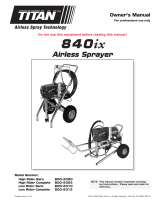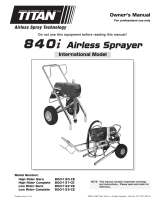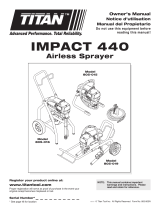
17
PRESCRIPTIONS DE SÉCURITÉ
IMPACT 1040
de sécurité et de durée de vie, utiliser exclusivement des tuyaux
exibles à haute pression d‘origine de TITAN.
• Ce système peut produire une pression de 3 300 PSI / 22,8 MPa.
N’utilisez que les pièces de rechange ou les accessoires spéciés
par le fabricant et ayant une pression nominale minimum de 3
300 PSI. Ceci est valable pour les embouts de pulvérisation, les
protecteurs de buse, les pistolets, les rallonges, les raccords et le
tuyau.
• Verrouillez toujours la détente quand vous ne pulvérisez pas.
Vériez que le verrou de la détente fonctionne correctement.
• Vériez que toutes les connexions sont bien serrées avant d’utiliser
l’appareil.
• Sachez comment arrêter l’appareil et le dépressuriser rapidement.
Soyez bien familiarisé avec les commandes. La pression n’est pas
libérée lorsque le moteur est arrêté. La poignée du robinet-valve
PRIME/SPRAY doit être placée sur PRIME pour libérer la pression.
Consultez la PROCÉDURE DE DÉCOMPRESSION décrite dans le
manuel de la pompe.
• Retirez toujours l’embout de pulvérisation avant de rincer ou de
nettoyer le système.
REMARQUE À L’INTENTION DES MÉDECINS :
Les injections cutanées sont des lésions
traumatiques; il importe donc de les traiter sans
délai. On NE DOIT PAS retarder ce traitement
sous prétexte de vérier la toxicité du produit en
cause, celle-ci n’étant conséquente que dans le
cas d’injection directe de certains produits dans
le système sanguin. Il pourrait s’avérer nécessaire
de consulter un plasticien ou un spécialiste en
chirurgie reconstructive de la main.
RISQUE : FLEXIBLE À HAUTE
PRESSION
Le tuyau de peinture peut présenter des fuites dues à
l’usure, aux pincements et aux mauvaises utilisations.
Toute fuite peut entraîner une projection de matériau
dans la peau. Vériez soigneusement le tuyau avant
chaque utilisation.
PRÉVENTION :
• Il faut éviter de trop plier le exible; le plus petit rayon ne doit pas
être inférieur à 20 cm.
• Protéger le exible contre le passage de véhicules et éviter le
frottement sur des arêtes vives.
• Remplacer immédiatement tout tuyau à haute pression
endommagé.
• Ne jamais essayer de réparer un exible endommagé!
• La charge électrostatique du pistolet et du exible est évacuée
par ce dernier. Pour cette raison, la résistance électrique entre les
raccords du exible doit être égale ou inférieure à 1 mégaohm.
• Pour des raisons de fonctionnement, de sécurité et de durée utile
utiliser exclusivement des exibles à haute pression originaux de
Titan.
• Avant chaque utilisation, vériez que les tuyaux ne présentent
ni coupures, ni fuites, ni signent d’abrasion ou de renement
du revêtement. Vériez l’état et le mouvement des raccords.
Remplacez immédiatement les tuyaux s’ils sont en mauvais état.
Ne réparez jamais un tuyau de peinture. Remplacez-le par un tuyau
à haute-pression relié à la masse.
• Assurez vous que le tuyau à air et les tuyaux de pulvérisation sont
disposés de façon à éviter les risques de glissade, de trébuchement
ou de chute.
RISQUE : EXPLOSION ET INCENDIE
Les vapeurs inammables, telles que les vapeurs de
solvant et de peinture, dans une zone de travail peuvent
s’enammer ou exploser.
PRÉVENTION :
• Ne pulvérisez pas de matières inammables ou combustibles près
d’une amme nue, de voyants lumineux ou de sources d’ignition
telles que des objets chauds, cigarettes, moteurs, matériel
et appareils électriques. Évitez de produire des étincelles en
connectant et en déconnectant les cordons électriques.
• S’entourer de toutes les précautions possibles lorsqu’on utilise
des produits ayant un point d’éclair inférieur à 38°C (100°F). Le
point d’éclair est la température à laquelle le liquide peut créer
susamment de vapeurs et s’enammer.
• L’écoulement de peinture ou de solvant dans l’équipement peut
produire de l’électricité statique. L’électricité statique crée un risque
d’incendie ou d’explosion en présence de fumées de peinture
ou de solvant. Toutes les pièces du système du pulvérisateur, y
compris la pompe, l’ensemble du tuyau, le pistolet de pulvérisation
et les objets dans et autour de la zone de pulvérisation doivent être
correctement reliés à la terre pour protéger contre les décharges
d’électricité statique et les étincelles. N’utilisez que des tuyaux
conducteurs ou reliés à la terre pour pulvérisateurs de peinture
sous vide à haute pression, spéciés par le fabricant.
• Vériez que tous les conteneurs ou systèmes de stockage sont
reliés à la terre pour éviter les décharges d’électricité statique.
• N’utilisez pas de peinture ou de solvant contenant du halon, par
exemple, le chlore, les agents antimoisissure à l’eau de Javel,
le chlorure de méthylène et le trichloroéthane. Ils ne sont pas
compatibles avec l’aluminium. Contactez le fournisseur de
revêtements pour connaître la compatibilité du matériau avec
l’aluminium.
• La zone de pulvérisation doit toujours être bien aérée. Une
bonne quantité d’air frais doit constamment traverser la zone
de pulvérisation pour éviter les accumulations de vapeurs
inammables. Le système de pompage doit être placé dans une
zone bien aérée. Ne pulvérisez pas le système de pompage.
• Ne fumez pas dans la zone de pulvérisation.
• N’actionnez pas d’interrupteurs électriques, de moteurs ou autres
dispositifs produisant des étincelles dans la zone de pulvérisation.
• Maintenez la propreté de la zone et veillez à ce qu’elle ne contienne
pas de conteneurs de peinture ou de solvant, de chions et autres
matières inammables.
• Sachez ce que contiennent la peinture et les solvants pulvérisés.
Lisez les ches de sécurité du matériel (SDS) et les étiquettes
apposées sur les conteneurs de peintures et de solvants. Respectez
les consignes de sécurité du fabricant de peinture et de solvant.
• Placez la pompe à une distance minimum de 6,1 mètres (20 pieds)
de l’objet à pulvériser, dans une zone bien aérée (ajoutez de la
longueur de tuyau si besoin est). Les vapeurs inammables sont






















